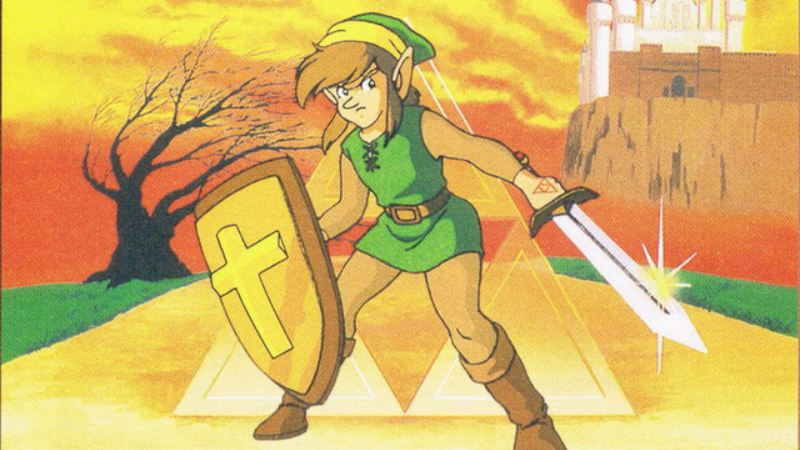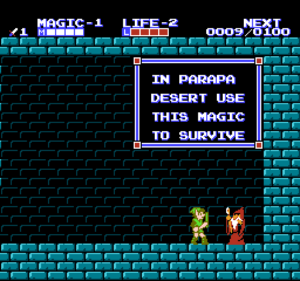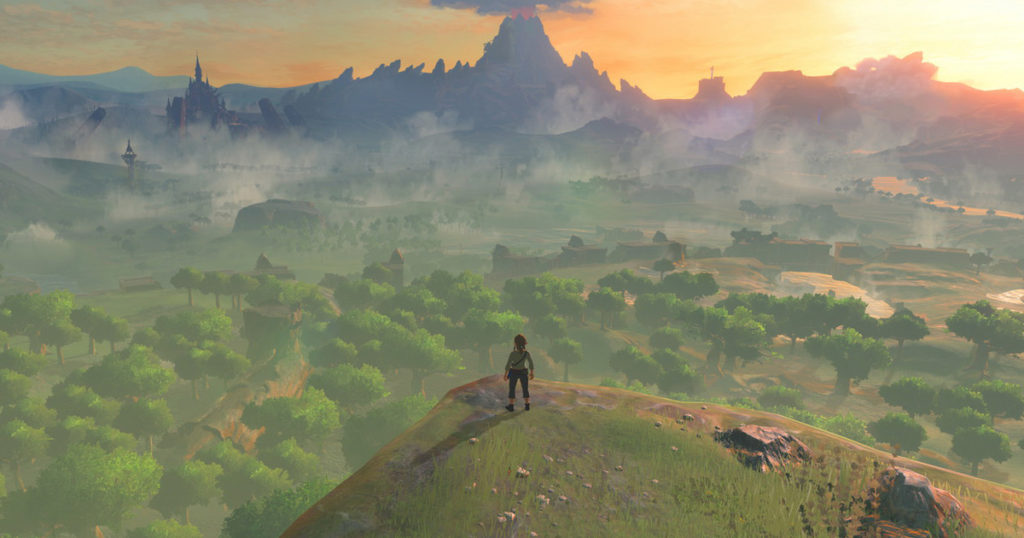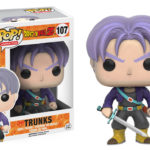
2016 marked the 30th anniversary of The Legend of Zelda franchise. Nintendo celebrated this landmark with… little fanfare. Other than a few limited-edition amiibos and the promise of a game yet to come, it seemed like the event went almost eerily unnoticed. Longtime fans may have felt slighted by the minimal celebration, but all is not lost! Today is the 30th anniversary of the second game in the franchise, after all. And as much as I might be grasping at straws, I think there’s a bit of a method to Nintendo’s madness. Call me a conspiracy theorist, but I think Breath of the Wild is taking a number of lessons from Zelda II: The Adventure of Link.
Explore a Living World
 The Legend of Zelda is famous for introducing the franchise with a freely explorable open world and most seem excited for a return to that style. Yet looking critically at that first game, the actual world was pretty dead. Sure it’s filled with lots of different regions, but who’s actually living in these empty landscapes other than fearful old men hiding in caves? There’s an unmistakably apocalyptic element to The Legend of Zelda that’s never quite been captured since. It’s beautiful in its own way, but in a modern game? It simply wouldn’t do.
The Legend of Zelda is famous for introducing the franchise with a freely explorable open world and most seem excited for a return to that style. Yet looking critically at that first game, the actual world was pretty dead. Sure it’s filled with lots of different regions, but who’s actually living in these empty landscapes other than fearful old men hiding in caves? There’s an unmistakably apocalyptic element to The Legend of Zelda that’s never quite been captured since. It’s beautiful in its own way, but in a modern game? It simply wouldn’t do.
By contrast, Zelda II opened up that world to include towns, named characters, and areas that required an entirely new style of gameplay to traverse. You were still adventuring in crumbling temples, but when you got out of there, you found yourself having to go into town and talk to people to understand where to go next. The fact that these characters had homes and (implied) lives of their own meant so much to building the world. Error, a citizen of Ruto in Zelda II, has even become a sort of meme in Nintendo fandom, being referenced by Fracktail in Super Paper Mario and getting a cameo appearance in Hyrule Warriors Legends!
At the same time, Zelda II didn’t entirely civilize its world to accomplish this sense of life and livelihood either. The game used these towns as safe havens from a largely unforgiving world. You still had to venture into the unknown, overcome obstacles, and fight monsters. You were simply far less alone while doing so. If Breath of the Wild really wants to recapture the magic of Legend of Zelda in a modern context, it needs to remember the lesson Zelda II taught.
Level Up with RPG Elements
 Zelda II actually saw you levelling up your character, increasing your attack power, magic capacity, or life. While actual levelling never made its way back into any of the other mainstream Zelda titles so far, I wouldn’t be surprised if Breath of the Wild took some inspiration in the way it opened up its world rather than one item at a time. Being able to choose a tunic that lets you take less damage per hit for fire attacks at the exchange of being weak to water attacks, for example, may be just the thing a player needs to beat a certain boss. It’s a system that rewards strategy and thought.
Zelda II actually saw you levelling up your character, increasing your attack power, magic capacity, or life. While actual levelling never made its way back into any of the other mainstream Zelda titles so far, I wouldn’t be surprised if Breath of the Wild took some inspiration in the way it opened up its world rather than one item at a time. Being able to choose a tunic that lets you take less damage per hit for fire attacks at the exchange of being weak to water attacks, for example, may be just the thing a player needs to beat a certain boss. It’s a system that rewards strategy and thought.
One of the changes I’m the most excited for in Breath of the Wild is the reintroduction of these RPG elements. Skyward Sword showed some creeping development of this, as you could take your items to the bazaar for upgrades or repairs, but really, this was nothing more special than trading in the wooden sword for the white sword at the top of Death Mountain in The Legend of Zelda. The more complex system of choosing equipment based on location or ability seems like a return to Zelda II style customisation.
Breath of the Wild needs to be careful of this, of course. The complex levelling system is partially why so many were turned off by Zelda II. Still, with careful balance and learning from past mistakes, it’s fair to say Breath of the Wild has already earned enough goodwill to take that chance, and the result would entirely change the way we think about our equipment in a Zelda game.
Use Magic Wisely
 Zelda II was one of the few games in the franchise to fully utilise the concept of magic. I mean, yes, there were Wizzrobes in The Legend of Zelda that shot spells at you, but how different were they from Octoroks spitting rocks? There was no actual Magic Meter you wanted to fill up for Link’s own use. Zelda II saw Link actually learning spells such as Fire, Reflect, and Thunder to navigate the world. It was a crucial yet mysterious part of the game. Even the final boss of the game, Dark Link, seemed to be drawn from magic inherent to the world.
Zelda II was one of the few games in the franchise to fully utilise the concept of magic. I mean, yes, there were Wizzrobes in The Legend of Zelda that shot spells at you, but how different were they from Octoroks spitting rocks? There was no actual Magic Meter you wanted to fill up for Link’s own use. Zelda II saw Link actually learning spells such as Fire, Reflect, and Thunder to navigate the world. It was a crucial yet mysterious part of the game. Even the final boss of the game, Dark Link, seemed to be drawn from magic inherent to the world.
Since Zelda II, magic has since been best used when it brings something unknowable into the game. Ocarina of Time wowed me by letting Link use magic to cast Din’s Fire or Nayru’s Love to wield the power of the goddesses themselves. The Wind Waker used magic to give Link the ability to fly on a leaf. Skyward Sword understood what it was, and rather than trying to cover it up, it came right out and called the traditional magic bar stamina instead.
We still don’t know enough about Breath of the Wild to definitively say whether or not magic will be included, but it’s my hope that it will be there in a similarly mysterious and unknowable way. We’ve already seen technology as a large part of the gameplay. Maybe Link will use magic to fuel the technological marvels that we’ve seen so far.
Be Entirely New

If you were a gamer in 1987 who was asked to imagine a direct sequel to The Legend of Zelda, I doubt you would have imagined Zelda II. The fact that A Link to the Past exists in the state it does proves that. Going back to the top-down, item-based combat of The Legend of Zelda almost immediately, the developments of Zelda II still feel like they’re doing their own thing. Even the music, composed by Akito Nakatsuka rather than Koji Kondo, retained almost none of the classic Zelda themes from the first game. You were on an adventure into the unknown, and everything about the game, from its perspective, to its gameplay, to the visual design, was all designed to remind you of that fact.
Breath of the Wild is similarly carving its own path. There’s a reason this game took six years to develop. It looks entirely different from Skyward Sword both in terms of linearity and scope, and while I personally loved Skyward Sword for its focus on characters and story, I’m excited to see how Breath of the Wild surprises me with gameplay. I can only hope it’s as innovative and worthwhile as Zelda II.


![[OPINION] SUN TZU? MORE LIKE SUN WHO?! AM I RIGHT, STRATEGY GAME FANS?](https://geekd-out.com/wp-content/uploads/2020/08/AIWar4-150x150.jpg)


One thought on “What Could Breath of the Wild Learn From Zelda II?”